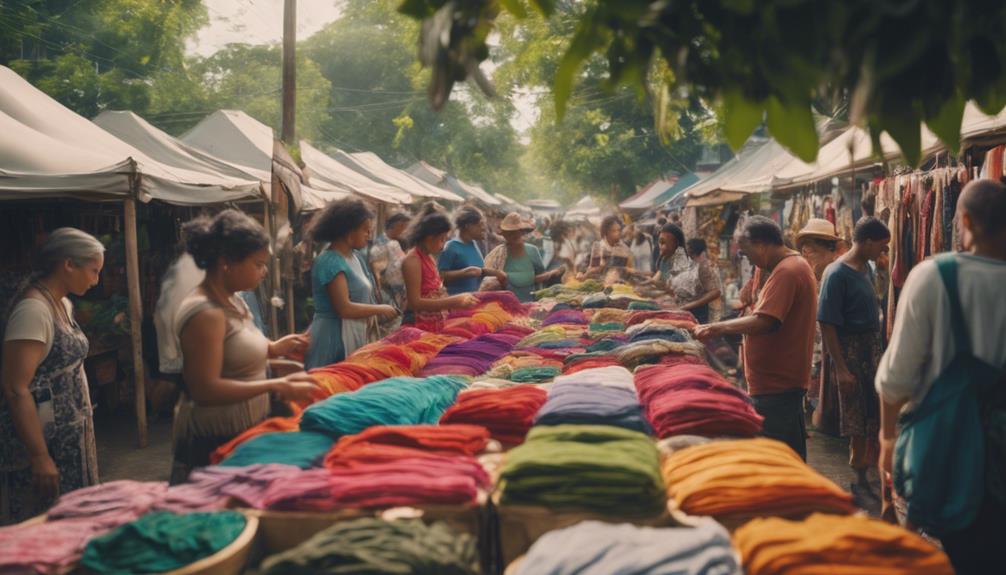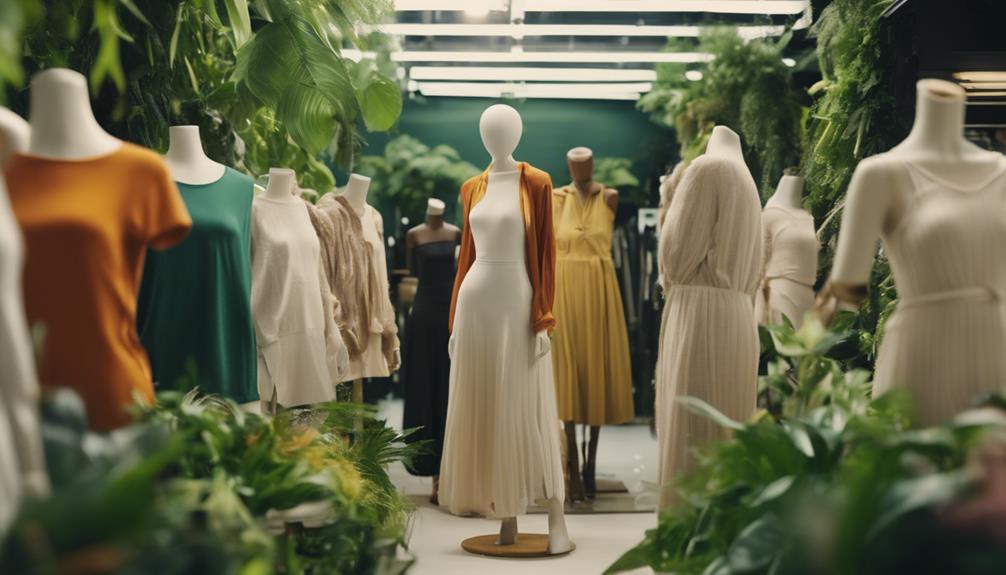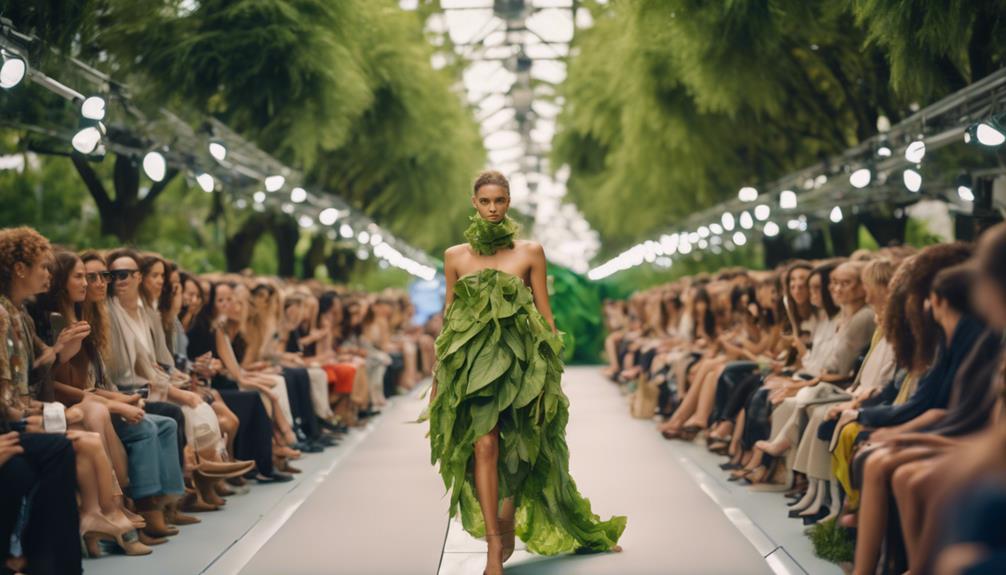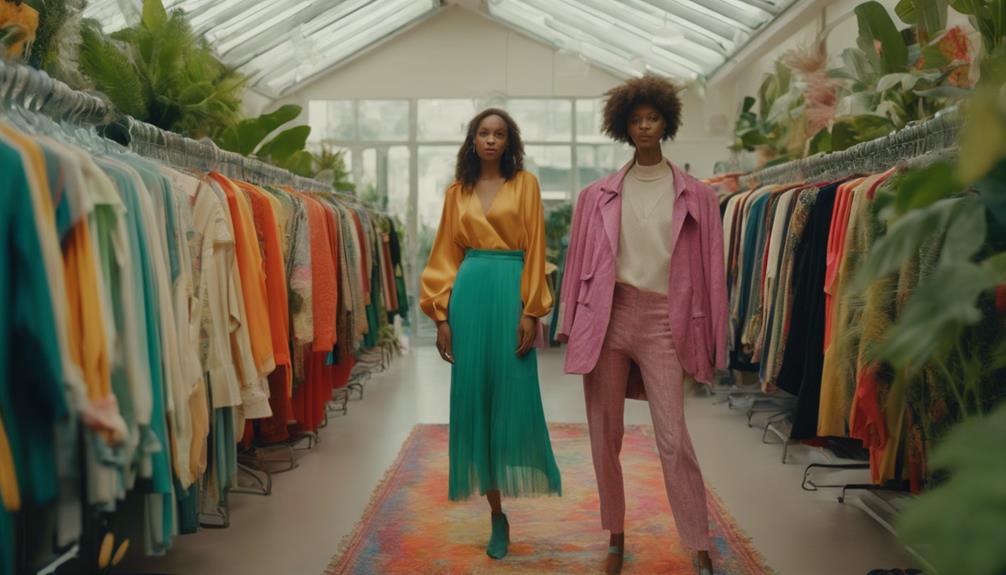You’ll never believe it, but the title of the most sustainable fashion designer goes to Yannik Zamboni! He has been recognized for his dedication to eco-friendly practices and inclusivity, with a focus on transparency and innovation. Zamboni’s creations demonstrate a profound understanding of the necessity for sustainable change within the fashion industry. His approach not only involves sustainable materials but also promotes gender inclusivity, which is making a significant impact in a traditionally exclusive field. If you’re interested in learning more about how his journey is influencing the fashion landscape, you should explore further the trends and practices that are reshaping sustainability in this dynamic industry.
Key Takeaways
- Stella McCartney is widely recognized for her commitment to sustainable luxury, avoiding leather and fur while using regenerated and organic materials.
- Gabriela Hearst made headlines by hosting the first carbon-neutral fashion show, showcasing her dedication to sustainability and innovative practices.
- Eileen Fisher emphasizes eco-friendly materials and fair trade practices, reinforcing sustainable fashion through her Green Eileen initiative.
- Mara Hoffman focuses on using recycled materials like Econyl, contributing to environmental protection and sustainability in fashion.
Defining Sustainable Fashion
Sustainable fashion focuses on eco-friendly practices that reduce waste and promote ethical production in the textile industry. It emphasizes using natural fibers like organic cotton and Tencel, which have a considerably lower environmental impact compared to synthetic materials. By embracing slow fashion principles, you choose quality over quantity, supporting items that are made to last rather than fast trends that contribute to waste.
The fashion industry is notorious for its pollution, with synthetic dyes and fabrics contaminating water sources and contributing to microplastic pollution. This highlights the urgent need for sustainable alternatives that prioritize our planet's health. Returning to natural fibers not only reduces these harmful effects but also aligns with a growing consumer demand for transparency and ethical sourcing.
Incorporating local production and collaborating with artisans, sustainable fashion draws inspiration from nature through biomimicry, creating innovative designs that respect both the environment and the craft of garment-making.
The Criteria for Evaluation

When evaluating sustainable fashion designers, you'll want to focus on two critical points: environmental impact assessment and ethical labor practices.
By examining how designers source materials and treat their workers, you can get a clear picture of their commitment to sustainability.
This understanding helps you make informed choices about the brands you support.
Environmental Impact Assessment
Environmental impact assessments in fashion focus on evaluating resource consumption, waste generation, and carbon emissions linked to production processes. These assessments help you understand how a designer's practices affect the planet.
Here are four key criteria to take into account:
- Sustainable Materials: Designers should prioritize using sustainable practices, like organic cotton and recycled textiles, to lessen their environmental footprint.
- Life Cycle Analysis: It's essential to evaluate the durability, repairability, and recyclability of garments, promoting a circular fashion approach.
- Supply Chain Transparency: Designers who openly disclose their sourcing practices and labor conditions tend to score higher in sustainability evaluations. Transparency is important for trust and accountability.
- Certifications: Look for certifications like B-Corp, Global Organic Textile Standard (GOTS), and Fair Trade. These benchmarks demonstrate a designer's commitment to both environmental and social responsibility.
Ethical Labor Practices
Ethical labor practices in fashion guarantee workers receive fair wages and operate in safe conditions, creating a more just industry for everyone involved. When you consider sustainable fashion, evaluating brands on their labor practices is crucial. Here's a quick breakdown of key criteria to look for:
| Criteria | Description | Importance |
|---|---|---|
| Fair Wages | Compensation reflecting skills and efforts | Supports economic stability |
| Safe Working Conditions | Environments free from hazards | Guarantees worker health and safety |
| Right to Unionize | Empowering workers to organize | Promotes collective bargaining |
| Transparency | Disclosure of sourcing and practices | Builds consumer trust |
| Third-Party Certifications | Validation through Fair Trade and B Corp | Identifies socially responsible brands |
When you choose brands that prioritize ethical labor practices, you're not just supporting sustainable fashion; you're advocating for fair trade and a more equitable industry. Opt for designers who empower their workers and maintain transparency, guaranteeing your fashion choices contribute positively to the global community.
Influential Sustainable Designers

Influential sustainable designers like Stella McCartney and Gabriela Hearst are reshaping the fashion industry by prioritizing eco-friendly practices and innovative materials. You'll see how these designers set the standard for sustainability in fashion:
- Stella McCartney: A pioneer since 2001, she avoids leather and fur, instead using regenerated cashmere and organic cotton to create luxury pieces.
- Gabriela Hearst: Known for her commitment to slow fashion, she hosted the first carbon-neutral fashion show at New York Fashion Week and uses 25% deadstock materials in her collections.
- Eileen Fisher: Launched Green Eileen in 2009, focusing on eco-friendly materials and fair trade initiatives while empowering consumers through storytelling about sustainability.
- Mara Hoffman: She utilizes eco-friendly materials like Econyl and Repreve, partnering with organizations to protect aquatic ecosystems and reduce environmental impact.
These designers don't just create clothing; they inspire a movement towards a more sustainable future in fashion. By embracing eco-friendly practices, they challenge the status quo and encourage you to reflect on the impact of your fashion choices.
Leading Sustainable Fashion Brands

When you explore leading sustainable fashion brands, you'll notice their commitment to innovative materials and ethical production practices.
These brands not only create stylish collections but also prioritize the planet and the people behind their products.
Innovative Materials Usage
Innovating with materials, leading sustainable fashion brands are transforming the industry by using eco-friendly alternatives that reduce environmental impact.
These sustainable brands are stepping away from the traditional fast fashion model, opting for innovative materials that promote a healthier planet.
Here are some key examples of how they're making a difference:
- Stella McCartney: She's renowned for using regenerated cashmere and sustainable viscose, steering clear of leather and fur since 2001.
- Mara Hoffman: Incorporates materials like Econyl, which turns nylon waste into durable yarn, and Repreve, made from recycled plastic bottles.
- Gabriela Hearst: Emphasizes circularity by reusing antique Turkish rugs and recycled cashmere, notably minimizing waste.
- MUD Jeans: Pioneers a circular economy approach in denim, offering a leasing model while using organic cotton and recycled materials.
Ethical Production Practices
Leading sustainable fashion brands prioritize ethical production practices to guarantee fair wages and safe working conditions for their workers, directly impacting the lives of those in their supply chains.
For instance, Eileen Fisher emphasizes fair trade certification, ensuring that their workers are compensated fairly and treated with respect. Brands like Thought Clothing take it a step further by focusing on local sourcing, which not only supports local economies but also reduces carbon emissions linked to transportation.
Additionally, companies such as Amour Vert adopt a small batch production model, which limits waste and encourages a commitment to quality. Everlane stands out for its transparency in supply chains, openly sharing pricing structures and factory locations, fostering trust among consumers.
Patagonia also leads the charge by implementing worker empowerment initiatives, which enhance skill development while upholding ethical labor standards.
Innovative Materials in Fashion

Sustainable fashion is transforming the industry with innovative materials that prioritize both environmental responsibility and style. As you explore this new wave, you'll discover materials that not only look good but also do good for the planet. Here are some game-changing options:
- Tencel: Made from sustainably sourced wood pulp, it's biodegradable and compostable, making it a favorite among eco-conscious brands.
- Econyl: This regenerated nylon is crafted from ocean and landfill waste, creating durable garments while helping to reduce plastic pollution.
- Pinatex: Derived from pineapple leaf fibers, this sustainable alternative to leather supports local farmers and reduces agricultural waste.
- Recycled polyester: Made from post-consumer plastic bottles, it diverts waste from landfills and cuts down on the energy needed for virgin polyester production.
These innovative materials are revolutionizing the fashion industry, proving that sustainable choices can be stylish.
Local Production and Community Impact

When you choose local production, you're not just supporting ethical manufacturing practices; you're also uplifting your community.
By collaborating with local artisans, you help preserve traditional craftsmanship and create jobs that empower workers.
This approach leads to a more equitable fashion ecosystem, benefiting everyone involved.
Ethical Manufacturing Practices
Ethical manufacturing practices focus on local production, cutting transportation emissions while boosting the local economy through job creation. By choosing local sources, you not only reduce your carbon footprint but also foster a thriving community.
Here are some key benefits of ethical manufacturing practices:
- Job Creation: Local production generates employment opportunities, empowering community members and reducing unemployment rates.
- Preservation of Craftsmanship: Collaborating with local artisans helps maintain traditional skills and cultural heritage, guaranteeing craftsmanship is valued and passed down.
- Fair Trade Principles: Implementing fair trade guarantees workers receive fair wages and safe working conditions, promoting equity in the fashion industry.
- Economic Reinforcement: Profits from local production are often reinvested into the community, creating long-term benefits that enhance both social and environmental sustainability.
Supporting Local Communities
Supporting local communities through fashion not only reduces carbon footprints but also fosters economic growth and resilience. When you choose sustainable fashion that emphasizes local production, you directly contribute to fair trade practices. This guarantees artisans receive equitable wages and work in safe conditions, enhancing their quality of life.
By collaborating with local artisans, you help preserve traditional African crafting techniques, promoting cultural heritage and allowing unique, handcrafted items to thrive in the marketplace. Local sourcing of materials reduces reliance on synthetic textiles, making the supply chain more eco-friendly.
Here's a summary of the benefits of supporting local communities:
| Benefits | Description |
|---|---|
| Economic Growth | Creates jobs and encourages entrepreneurship |
| Environmental Impact | Reduces transportation needs and carbon footprints |
| Cultural Preservation | Maintains traditional crafting techniques |
| Quality of Life Improvement | Guarantees fair wages and safe working conditions for artisans |
Engaging in local production not only boosts community resilience but also connects you to the rich cultural narratives behind the clothes you wear. Choose sustainable fashion that empowers local artisans today!
Awards and Recognitions

Sustainable fashion designers have garnered widespread recognition for their innovative approaches and unwavering commitment to ethical practices, setting new standards in the industry. Their efforts haven't gone unnoticed, earning them various awards and recognitions that highlight their impact in the world of fashion.
Here are some notable examples:
- Stella McCartney: A pioneer in sustainable luxury fashion since 2001, she's received numerous accolades for her cruelty-free practices and innovative materials.
- Christina Dean: Founder of Redress and named one of the 'Top 30 Inspirational Women' by UK Vogue, she's recognized for her efforts in reducing fashion waste.
- Livia Firth: Co-founder of Eco-Age, she received the UN Fashion 4 Development Award and the Rainforest Alliance Award for Outstanding Achievement in Sustainability.
- Carry Somers: As the founder of Fashion Revolution, she led her fair-trade brand, Pachacuti, to become the first certified under the World Fair Trade Organization.
These designers and their fashion brands not only redefine style but also inspire a movement towards sustainability in the industry, proving that ethical practices can indeed lead to recognition and success.
The Role of Consumer Awareness

Recognizing the impact of sustainable fashion designers is just the beginning; understanding consumer awareness is key to driving the demand for eco-friendly practices in the industry. As you become more informed about sustainable fashion, your choices can greatly influence market trends. When you prioritize brands that focus on ethical production and eco-friendly practices, you help push the industry toward a greener future.
Education about the environmental impacts of clothing, such as pollution from synthetic dyes and microplastics, is essential. The more you know, the more you can advocate for sustainable alternatives. Marketing strategies that highlight the benefits of natural fibers and dyes can also reshape your perceptions and purchasing decisions.
Moreover, understanding the history of fashion materials empowers you to make conscious wardrobe choices. By supporting local production and brands that prioritize sustainability, you're contributing to a fashion industry that values ecological and social well-being.
Your consumer awareness isn't just a personal choice; it's a powerful tool for change that can inspire others to embrace sustainable fashion as a viable and responsible option.
Future Trends in Sustainable Fashion

As consumers increasingly prioritize eco-friendly choices, the future of fashion is shifting towards innovative practices that embrace sustainability at every level. You'll notice several key trends emerging that signal this exciting transformation:
- Circular Fashion: Brands are adopting circular fashion models, focusing on recycling and reusing materials to minimize waste and extend product life cycles.
- Biodegradable Materials: Designers are experimenting with fully compostable fabrics, creating garments that break down naturally, which supports sustainability efforts.
- Digital Fashion: The rise of digital fashion offers a sustainable alternative, allowing you to purchase virtual clothing that reduces physical waste and resource consumption.
- Technology Integration: The use of AI and blockchain technology is enhancing transparency and traceability in fashion supply chains, making it easier for you to choose sustainably sourced products.
As an eco-conscious consumer, you're driving this shift. Your demand for ethical practices and transparency compels brands to prioritize sustainability, ultimately reshaping the industry.
The Winner Revealed!

The recent announcement of Yannik Zamboni as the winner of 'Making the Cut' Season 3 highlights the growing importance of sustainability and inclusivity in the fashion industry. Known for his non-binary approach, Zamboni's brand, Maison Blanche, champions sustainable fashion through its commitment to gender inclusivity. His innovative designs reflect a deep understanding of the need for change within the industry.
Here's a closer look at Zamboni's approach:
| Pillar of Sustainability | Description | Impact |
|---|---|---|
| Economic | Focus on fair wages and local sourcing | Supports local economies |
| Ecological | Use of sustainable materials | Reduces environmental impact |
| Ethical Moral | Transparent production practices | Builds consumer trust |
| Social Political | Advocacy for marginalized communities | Promotes inclusivity and representation |
Zamboni's journey involved two years of research, overcoming funding challenges to implement significant changes. Now, with a collaboration with Amazon, he's set to launch two fashion lines emphasizing sustainable practices. Future projects include a gender-inclusive perfume line and high-end Swiss-made products. Zamboni's vision for Maison Blanche is a reflection of creativity, sustainability, and inclusivity in fashion.
Frequently Asked Questions
Who Is the Most Ethical Fashion Designer?
When considering the most ethical fashion designer, you should look at those prioritizing fair labor practices, environmentally friendly materials, and transparency in production. Each designer brings unique values, so choose one that aligns with your beliefs.
Who Is the Most Sustainable Fashion Brand?
You won't believe the sheer brilliance of sustainable fashion brands today! When you explore options like Patagonia, Reformation, or MUD Jeans, you'll discover innovative practices that redefine eco-consciousness in style—making your wardrobe positively radiant with sustainability!
Which Luxury Brand Is Not Sustainable?
Many luxury brands aren't sustainable due to high carbon footprints, use of harmful materials, and exploitative labor practices. It's crucial to scrutinize their production methods and supply chains to understand their true environmental impact.
Who Is a Sustainable Fashion Designer?
Did you know that sustainable fashion designers use up to 90% less water than traditional brands? You'll find designers like Stella McCartney and Eileen Fisher, who focus on eco-friendly materials and ethical production practices.
Conclusion
In the world of fashion, sustainability shines like a beacon guiding us toward a better future.
As you embrace conscious choices and support innovative designers, you play a crucial role in this transformation.
Remember, every purchase you make is a vote for the kind of world you want to live in.
So, let's champion the sustainable fashion movement together, ensuring that the winner isn't just one designer, but the planet we all share. By supporting sustainable fashion, we can make a positive impact on the environment and the people involved in the fashion industry. It’s important to raise awareness and encourage others to make ethical and environmentally conscious fashion choices. We can all play a part in making a difference, whether we’re a fashion influencer, a conscious consumer, or a marc fashion designer.









